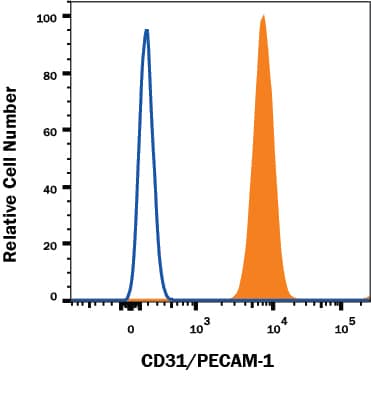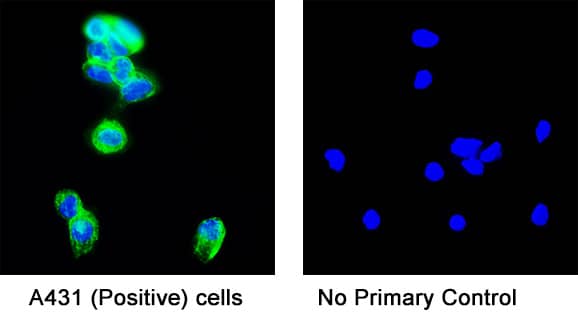Human Azurocidin/CAP37/HBP Antibody Summary
Ile27-Pro250
Accession # P20160
Customers also Viewed
Applications
under non-reducing conditions only
Please Note: Optimal dilutions should be determined by each laboratory for each application. General Protocols are available in the Technical Information section on our website.
Preparation and Storage
- 12 months from date of receipt, -20 to -70 °C as supplied.
- 1 month, 2 to 8 °C under sterile conditions after reconstitution.
- 6 months, -20 to -70 °C under sterile conditions after reconstitution.
Background: Azurocidin/CAP37/HBP
Azurocidin, also known as cationic antimicrobial protein 37 (CAP37) and heparin-binding protein (HBP), is a member of the serine protease family that includes Cathepsin G, neutrophil elastase (NE), and proteinase 3 (PR3). These proteases are found in the specialized azurophilic granules of neutrophils (1, 2). Human Azurocidin 1 is encoded by the AZU1 gene located in a cluster with NE and PR3 on chromosome 19pter (2). The open reading frame predicts a 251 amino acid (aa) protein with an N-terminal 26 aa signal sequence and a 7 aa propeptide. There are also eight cysteine residues and 3 putative N-linked glycosylation sites (1). Although Azurocidin 1 shares a significant degree of aa sequence identity with Cathepsin G, NE, and PR3, it lacks serine protease activity due to mutations at two of the three residues in the catalytic triad (His41Ser and Ser175Gly) (1, 3). Crystallographic analysis suggests that the antibacterial activity of Azurocidin is mediated by a hydrophobic pocket (residues 20 to 44) that binds Gram-negative bacteria lipid A. These structural data also imply that the heparin binding capacity is mediated by non-specific electrostatic interactions between the negatively charged heparin molecule and a large patch of positively charged residues near the lipid A binding site (3). Azurocidin has also been identified as a modulator of endothelial permeability. Neutrophils arriving first at sites of inflammation release Azurocidin, which acts in a paracrine fashion on endothelial cells causing the development of intercellular gaps and allowing leukocyte extravasation. These findings imply that Azurocidin may be a reasonable therapeutic target for a variety of inflammatory disease conditions (4).
- Morgan, J.G. et al. (1991) J. Immunol. 147:3210.
- Zimmer, M. et al. (1992) Proc. Natl. Acad. Sci. USA 89:8215.
- Iverson, L.F. et al. (1997) Nat. Struct. Biol. 4:265.
- Gautam, N. et al. (2001) Nat. Med. 7:1123.
Product Datasheets
Citations for Human Azurocidin/CAP37/HBP Antibody
R&D Systems personnel manually curate a database that contains references using R&D Systems products. The data collected includes not only links to publications in PubMed, but also provides information about sample types, species, and experimental conditions.
2
Citations: Showing 1 - 2
Filter your results:
Filter by:
-
Human Platelets Contain, Translate, and Secrete Azurocidin; A Novel Effect on Hemostasis
Authors: AS Aquino-Dom, V Acevedo-Sá, DS Cruz-Herná, SR Sánchez-Ap, MLÁ Romero-Tla, R Baltiérrez, LM Sánchez-Na, H Torres-Agu, J Bustos-Arr, SR Aguilar-Ru
International Journal of Molecular Sciences, 2022-05-18;23(10):.
Species: Human
Sample Types: Whole Cells
Applications: Flow Cytometry -
Phenol-soluble modulin ?4 mediates Staphylococcus aureus-associated vascular leakage by stimulating heparin-binding protein release from neutrophils
Sci Rep, 2016-07-07;6(0):29373.
Species: Human
Sample Types: Cell Culture Supernates
Applications: ELISA Development
FAQs
No product specific FAQs exist for this product, however you may
View all Antibody FAQsIsotype Controls
Reconstitution Buffers
Secondary Antibodies
Reviews for Human Azurocidin/CAP37/HBP Antibody
There are currently no reviews for this product. Be the first to review Human Azurocidin/CAP37/HBP Antibody and earn rewards!
Have you used Human Azurocidin/CAP37/HBP Antibody?
Submit a review and receive an Amazon gift card.
$25/€18/£15/$25CAN/¥75 Yuan/¥2500 Yen for a review with an image
$10/€7/£6/$10 CAD/¥70 Yuan/¥1110 Yen for a review without an image












